Note
Hey I just wanted to say that I really like your blog and I hope you continue to add things to it!
Thanks so much for saying so!
We're just a group of nerds who like playing games and thinking about geopolitics, and there will be more things coming eventually.
We have a gigantic master document of a BUNCH of drafts and bullet-points, but it's a matter of filtering that down from incoherent and inconsistent thoughts into something that at least kind of makes some sense.
We're also looking at rebooting some of our campaign content so that will help with figuring out the direction of the world-building and strengthening what we already have.
We're glad that you enjoy our little homebrew re-imagining :)
2 notes
·
View notes
Note
Do you think the Chasind were influenced by Mongolia as well?
So there's two different breakdowns I could do for this: what WE running the blog think the Chasind could be influenced from, and what the evidence in the Bioware lore (BL) presents to us. I want to stress again that we are NOT cultural experts , but we try and research and provide accurate information as much as we can.
This got REALLY long so I'm dropping it below the cut
The way our funny little group interprets and pulls inspiration from cultures in Thedas is basically just a blueprint or a road map. You'll see in some of the posts and definitely in things as we continue to post them that we use a lot of vague language when describing people. We want to avoid force-fitting players into certain roles or making people feel that "oh, well this region is inspired by this culture, so I guess I'll have to play that". Thorgan's Guide aims to spread out more opportunities for players to see themselves in this world and feel safe as they play.
So, right now, we are looking at the Chasind as a mixture of different cultures coming from early-colonial America and the Caribbean. That doesn't mean that Mongolian influence can't be added, and that is where we want there to be freedom for everyone playing the game.
Our drafts for Avvar/Frostback Basin cultures have definitely pin-pointed cultural inspiration from Inuit/Sami/Mongolian cultures, so even in our silly little home-brewed re-imagining, the geographical locations of the Frostback and the Kocari wilds are not far from each other, and it would totally work and would definitely be worth exploring for us. But I want to stress this again: our homebrew isn't meant to be law and we want everyone to have fun with it.
As for Bioware evidence, I have so many issues with it. My interpretation of the BL around Chasind features a lot of negative stereotypes associated with "uncivilized cultures," which basically translates to non-eurocentric. There is already a blatant lack of diverse ethnicities in the BL, but if I were to name a few cultures that were meant to be non-white representations, they all have antagonistic qualities to them - Chasind included. Tumblr user @dalishious talks a lot about how Bioware codes their people and cultures based on what suits them and how this can be damaging to real-world people [1]. (Dalishious' resources and research into this matter is a wealth of information, and I would highly recommend checking out their other work).
The Chasind are described as barbaric and "primitive at best". Based on pre-existing stereotypes of Mongolian culture (keyword stereotypes), it follows a similar pattern. With many minority cultures, they are placed into the ideas of "nomadic" and "simple", having technology seen as under-advanced in the face of Western civilization - so this, in its own twisted way, falls into the category. We are encouraged to see the Chasind as simple-minded and aggressive, told that they raid the swampland and cause harm and strike fear. Many brown-skinned cultures are subject to similar treatment depicting brutal warriors and merciless attacks, and of course, the antagonistic coding of Thedas cultures fits the Chasind into this role.
One thing that stuck out was the line "some Chasind are reputedly so barbaric that they even consume the flesh of the dead." The cannibalism stereotype was present in almost every dark-skinned representation at some point in time, using the "disgust" or "savagery" of the practice to separate civilized from uncivilized [2] [3]. Though appearing across the globe, these stereotypes intensified in mainstream media and specifically in films involving South American, Caribbean, and Pacific Islander cultures [4] [5].
In another line, we see "Chasind are known to decorate their hair with pierced copper coins; these are tied into the ends of their braids." This in itself is vague and, in reality, could reference dozens of different cultures around the globe. Many Slavic cultures had hair accessories and braids, but so did many African regions. It does not help that the Bioware games choose to darken the Chasind skin in their depictions. This usually leads our mind into thinking that they are meant to portray a certain culture or people based on our inherent beliefs and subconscious biases.
Bioware's writing is confusing at best and utterly racist at worst. Most of their regions are either blatantly European or a melting pot of so many minority cultures boiled down that you can hardly tell where the original inspiration came from. Is it Mongolian, Slavic, African, or something else altogether? I don't even think Bioware knows this. Just looking at the wiki page makes my head spin at how many contradicting and overlapping things there are in Chasind culture and how many elements they've taken from all over the place. All I can really say on the matter is that the wiki is doing a lot of harm with it.
From Thorgan's Guide, we totally encourage the addition of cultures to the game, and if the Chasind have Mongolian influence for the players, awesome! From the Bioware standpoint, Mongolian cultures were another target of stereotyping and "othering", not only from the Western world but from China as well, and it is completely possible that those cultural elements could be reflected back in Bioware's ignorant writing.
I may have gotten a bit carried away in writing and completely BLASTING negative stereotyping. Hopefully, this was still an interesting take on it all and at least kinda makes sense.
Here are the sources if anyone wants them:
[1] Dalishious. (2019). Coding Does Not Inherently Equate to Representation. (Source)
[2] Pyleyev, M. (2016). How the Feeling of Disgust Went From Life-Saving to Dangerous. (Video)
[3] Selvam, A. (2018). ‘Black Panther’ Challenges a Bogus Food Stereotype. (Source)
[4] Moore, R. B. (1973). Carib "Cannibalism": A Study in Anthropological Stereotyping. (Source)
[5] Conklin, B. A. (1997). Consuming Images: Representations of Cannibalism on the Amazonian Frontier. (Source)
#answer#chasind#reimagining thedas#thorgans guide to thedas#world of thedas#dragon age ttrpg#dragon age tabletop
1 note
·
View note
Text
The Anderfels
A great expanse of sandstone and savanna holds the vibrancy of diverse people and cultural artistry. Connected by vast trade highways and driven by unique crafts, the Anderfels pull cultural inspirations from sub-saharan and West Africa.
Listen here!
View the rest of the playlist here
#world of thedas#music of thedas#tabletop music#playlist#ambient music#da ttrpg#dragon age rpg#dragon age#spotify#Spotify
2 notes
·
View notes
Text
Seheron
A contested and war-torn land filled with all sorts of dangers to those who do not know its ways. From prowling beasts to fatal landscapes, the mountains of Seheron will test your resolve in more than one way.
Horror/suspense style playlist for DA TTRPG
Listen here!
View the rest of the playlists here
#world of thedas#music of thedas#tabletop music#ambient music#playlist#da ttrpg#dragon age rpg#dragon age#spotify#Spotify
2 notes
·
View notes
Text
Through the Tombs of the Dead

Take your players through a three-level puzzling dungeon that pits them against ancient Mortalitasi architecture, wandering undead, and their own psyche. They will need to learn to work together and race against the clock before they, too, become another body in the tombs of the dead.
Estimated 3-5 hours
This one-shot is set for beginner-level characters (levels 1-3) but can be adjusted to suit your DM-ing needs.
Read the PDF here!
Or get the print-friendly (non-customized) PDF here!
Looking for Dragon Age inspired ambient music for your campaign? Click here!
#thorgans guide to thedas#thorgans campaign#oneshot#one shot campaign#dragon age rpg#tabletop resources#dragon age ttrpg#da ttrpg#da rpg#darpg#dragon age table top#dragon age
4 notes
·
View notes
Text
Deep Road and Dwarf Facts From Buried Pasts Adventure - Dragon Age Tabletop RPG
Bullet point list of the interesting bits I found, I've added the excerpts below the cut.
The Deep Roads and Thaigs are 2-4 miles (3.21 - 6.43 km) below sea level. Making them deeper in areas like those beneath mountains.
Mining galleries tunnel upwards into mountains while thaigs tunnel downward towards the mantle.
The environment of the Deep Roads can shift from shockingly cold to blistering hot depending on the area.
Thaigs are heated in old thaigs by lava but in newer (now abandoned) thaigs it was common to use steam.
If traveling the Deep Roads, carrying a light and heat source is required. Without a heat source you could die from the cold.
There is complete pitch darkness outside of the glow of lyrium or lights created by people.
Dwarves make oil lamp using nug and bronto fat.
The shadows are so long when a light source exists that it makes it hard to spot what might be lurking in the dark.
Sounds louder than a whisper will echo further than they would above ground in a space/passage.
Dwarves love wood instruments and design their spaces to allow for sounds to echo in thaigs, giving them an ever present hum poets have compared to the song of the Stone.
Dwarven stone-sense fades the longer you are on the surface.
Magic and lyrium resistance in the dwarves comes from the constant exposure of lyrium. When on the surface for too long that resistance will fade away completely.
Dwarves are masters in close quarter combat, favoring morning stars, crossbows, and shields.
Note: There are weird wordage/typos in the text itself that I didn't alter because I couldn't tell which way to go with so I've left it as is.
Deep in the Dark (page 3)
"...For those who have spent their entire life being able to see the horizon, the cramped, confusing conditions underground can be difficult to adjust to. The human and elven sense of direction is easy to lose underground, sound travels further as it echoes off the walls, the environment can be shockingly cold in one space and blistering hot in the next, and the cramped conditions impede the styles of fighting surface-dwellers will be used to..."
Light and Shadow (page 3)
"Above ground is never completely dark, even on a clouded moonless night. Underground, in uninhabited areas of the Deep Roads, the only light in the pitch darkness is that which the heroes bring with them and the glow of lyrium veins. The slightest obstruction creates a long shadow such that even with light characters are unlikely to be able to see everything within the reach of their light source. As characters move through the environment, everyone of those shadows will move in keeping, further hindering characters watching for creatures in the dark..."
Sound and Silence (page 3 & 4)
"Although the solid rock stops sound from traveling to completely sealed areas, anything louder than a whisper will echo much further than it would above ground along the passageways and chambers of the Deep Roads. The effect is especially pronounced on the roads themselves, as dwarves built their underground passageways long and straight with vaulted ceilings to greatly enhance the distance at which sound can be heard. The constant echoing combined with the dwarven love of deep wind instruments and song gives inhabited thaigs a background hum of sound that dwarven poets have compared to the Stone. Orzammar itself is never silent, and the impact of moving into the stillness of abandoned Roads beyond the city's control is greatly upsetting to dwarves who have lived with the comforting sense of community the background noise provides..."
"..Any parties with dwarves in them may find the dwarves natural stone sense a help or frustration. Dearves who spend most of their life underground will find the sense still sharp and comforting. By feeling the stone, navigation is easier. However, the sense fades the longer dwarves remain on the surface and when the darkest parts of the Deep Roads it can be a vague distraction as the sense is dulled and irritating, though not completely without use.
Heat and Fuel (page 4)
"The majority of the Deep Roads and thaigs are built about two to four miles beneath sea level, although in the Frostbacks that means they're actually much deeper beneath the surface. Dwarven mining galleries normally stretch up rather than down, tunneling up into the mountain regions of Ferelden and Orlais from beneath, while the thaigs themselves burrow downward toward pockets of lava that have moved up from the mantle. Most older thaigs (including Orzammar) have open regions of molten rock near their center that are used for heat, while more modern thaigs (ironically those more likely to be abandoned thanks to the darkspawn pushing the dwarven empire back on itself) used steam heating. Inhabited regions between thaigs are heated and lit by oilk lamps using the fat from nugs and brontos.
Away from lava or artificial heating, the Deep Roads are bitterly cold. The lack of weather is a mercy, but travelers that go too ling without a source of heat will begin to feel the effects. As their lanterns are likely the source of their heat as well as light, travelers must take extra care with the amount of fuel they have; the dwarven empire once maintained frequent waystations along the Roads for resupply, but running out of lamp oil in the modern Deep Roads can be a death sentence..."
Fighting at Close Quarters (page 4)
"The dwarves of Orzammar equip their rank-and-file soldiers with shields, maces, and crossbows, perfect for the cramped conditions they are expected to fight in. Skirmishing is a thing of the surface battlefield, except in the largest caverns. The dwarves train their warriors to block passageways with shieldwalls and corral disorganized opposition into killing grounds.
Height is the main restriction. The dwarves built the main tunnels of the Deep Roads with lofty ceiling clearance, and thaigs are usually organized facing into large caverns to give a sense of space, but private houses and other areas not intended for heavy traffic can be uncomfortably cramped to a human. The lack of space can get in the way of swinging the large weapons humans may be used to..."
Dwarven Magic Resistance (page 16)
"...The dwarven resistance to magic is the result of prolonged low-level exposure to lyrium in the Deep Roads and is also the reason Orzammar dwarves can handle lyrium in relative safety in amounts that would drive a human mad."
31 notes
·
View notes
Text
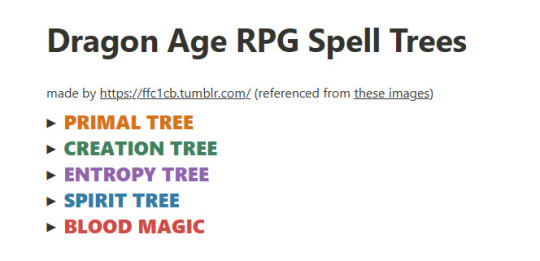
made a clickable directory of spell trees from darpg becos all i could find were images with no descriptions. idk if anyone might need these other than me but here they are (unfortunately only available in pdf (plaintext) and html (clunky interactive) formats because the site i made these with doesnt allow never-expiring links)
310 notes
·
View notes
Text

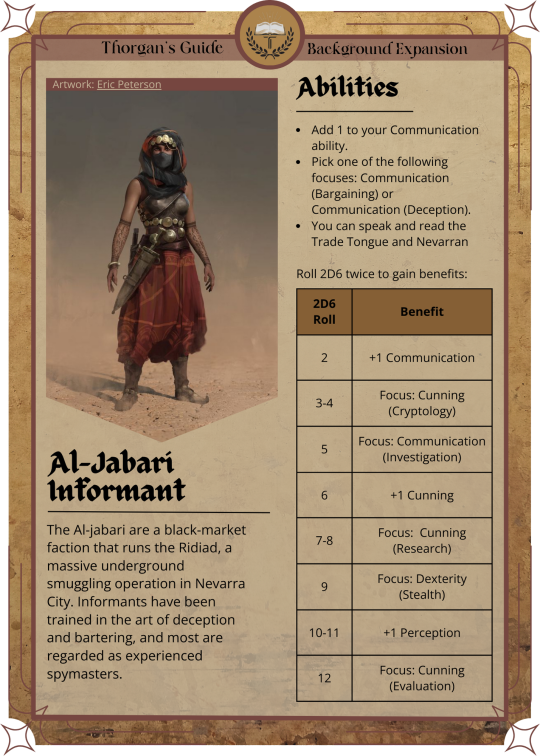


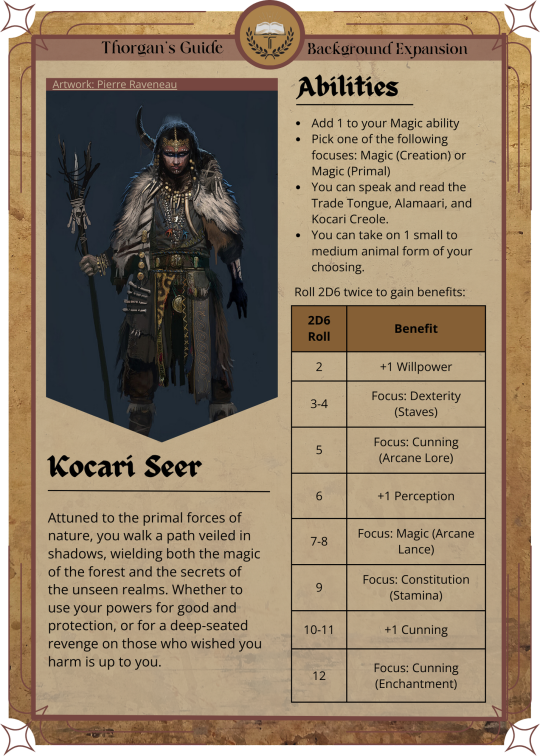

DA: TTRPG Character Background Expansion Part 1
Based on the re-imaginings of Thedas, here's a collection of character backgrounds to add to your library.
#thorgans guide to thedas#tabletop resources#character background#background expansion#da ttrpg#da rpg#dragon age ttrpg#dragon age rpg
5 notes
·
View notes
Note
Can you guys re-imagine the culture(s) of the Chasind?
Hey anon!
That's a fantastic suggestion! Our campaigns have been taking place mostly in northern Thedas, so we didn't even have Chasind people/Kocari Wilds on the map yet, but you're so right. I didn't know much about the Chasind before reading up on the Bioware Wiki (BW for short) and.....yooof.
We'll definitely do a more thought-out and 'official' entry, but since a lot of our re-imaginings move at a snail's pace, I'll share some of our immediate thoughts after discussing this:
Geography:
It's giving BIG bayou vibes, and we're taking that and running with it, nodding at inspiration of early Black-American culture that emerges in the southern USA and the greater Caribbean Islands. Visuals of the Florida Everglades and Bayou Bartholomew in Arkansas, with a majority of the villages being built on stilts or the massive trees that are similar to the ones seen in the Frostback Basin (Jaws of Hakkon DLC specifically). There are settlements on more solid land, but most of the population and the 'civilians' live inside the swamp, as the tricky terrain doubles as protection and security.
The People:
Based off the BW, we're seeing patterns of love for nature and the seasons, and the mention of "animalistic goddesses" is making us think....DND druid style. (we took one look at the "barbaric" descriptions and tossed it all out, thank you)
Animal companionship is common among Chasind, whether they are "working animals" that warriors and hunters may keep that help them in their tasks, or companions for your local shopkeep or fisherman. Big or small, smart or.....lovable...animals are all around and children may even receive their companion at very young ages, growing up with their animal friend.
Some more magically gifted Chasind can even transform and take an animal form.
Chasind are bonded by clan systems, not blood or background. Meaning that if someone needs help in the village, people will band together to support that person. Once you settle in the swamp, you're family.
The Chasind have a large population of people with darker skin tones, but people with lighter skin tones are not uncommon either.
The Culture
Being situated on top of it, of course, water is EVERYTHING.
Navigating the bayou is no easy feat, and children are taught from a young age through legends, stories, and all sorts of oral histories how dangerous the water can be.
There are definitely some pretty cool eldritch beings living out in the swamp, and there are definitely stories about them.
Fishing culture is HUGE. Fishermen are taught a very sophisticated type of navigation and tracking, most commonly using the stars as a guide to chart the swamp, because the landscape can be incredibly difficult to navigate, especially after dark.
According to the BW, the Chasind have "developed their own language, but are capable of speaking the King's tongue", so we took this as they've managed to blend an older language like the one spoken by their Alamaari ancestors and merged it with the King's tongue (not unlike real-world languages, such as Haitian Creole, Jamaican Patois, or Michif)
People also traverse the swamp on stilts to keep out of the water and out of the way of other water predators. Whether they are walking across the village or going out to the fishing holes to get a daily catch.
Please feel free to add your own comments or thoughts on this re-imagine! This entire project is a joint effort, and having perspectives from other backgrounds is always helpful to make it more inclusive.
#answer#idea sharing#reimagining thedas#thorgans guide to thedas#world of thedas#dragon age table top#dragon age ttrpg#chasind
16 notes
·
View notes
Text
Streets of Shadow: A Dragon Age Table Top Campaign
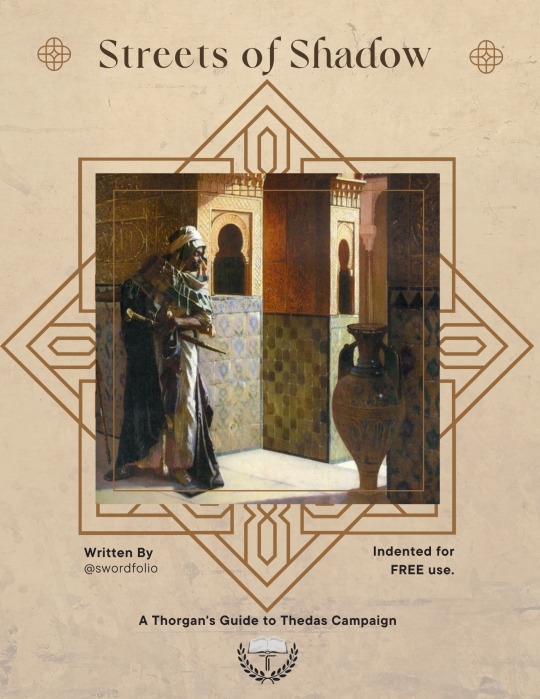
"The city of Highmire sits atop a mountain pass at the border between the Free Marches and Nevarra. This town controls much of the trade between the two countries, and its success was not so easily granted. Over the last several years, the trade empire that flows through the bottleneck of Highmire has been built out of the shadows of corruption and exploitation.
After the accidental murder of one of the city’s most beloved and cherished artisans, a rebellion is brewing in the shadows. Their anger in turn is being fueled by a mysterious killer who has begun targeting wealthy merchants in the upper-class district of the city.
It is up to the party to get to the bottom of this mystery and figure out what’s going on in Highmire. Will they see this killer as a heroic vigilante or a serial killer that must meet his end?"
Estimated 5-8 Sessions.
This campaign does not have any set levels and can accommodate an array of player characters and backgrounds. A majority of the set and world-building is written, but this is a campaign that you can make your own!
Read the PDF here!
Looking for Dragon Age inspired ambient music for your campaign? Click here!
#thorgans campaign#thorgans guide to thedas#darpg#darpg campaign#table top resources#camapign#tabletop campaign#dragon age ttrpg#dragon age table top#dragon age#campaign
29 notes
·
View notes
Text
These are three NPCs from a new campaign document we are hoping to release in the near future! :D
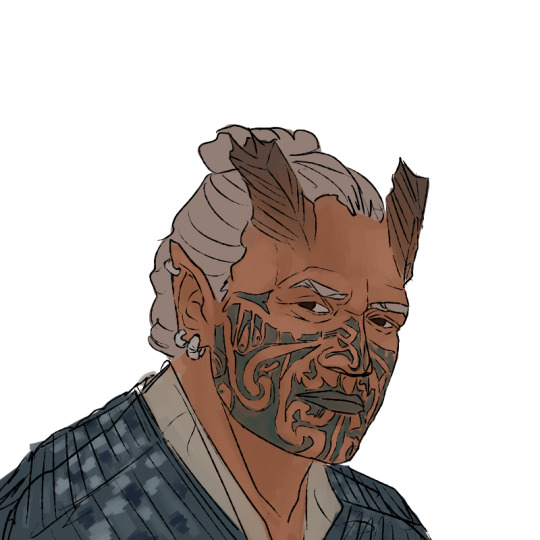
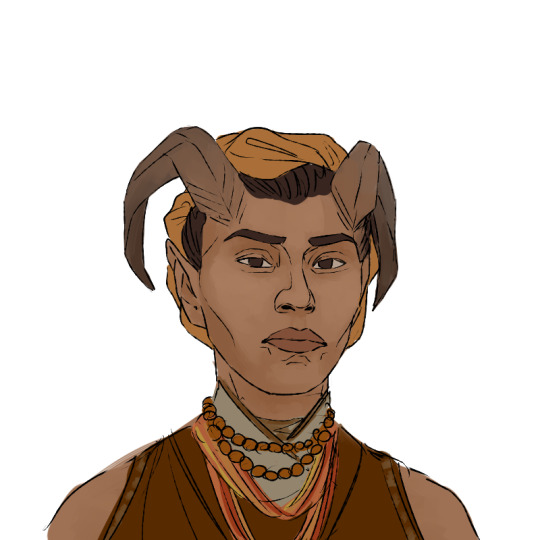

Qunari with styles and features from South America/Maori/Pasifika anyone?
This is done using the @thorgans-guide-to-thedas re-imagined Qunari lore and cultures :)
25 notes
·
View notes
Text
5e Conversion Guide for Dragon Age
So! YEARS ago my friends and I decided we wanted to play the Dragon Age TTRPG, which uses the AGE system, a 3d6 base system instead of based around a d20. Its cool, but has, some faults. In the end we wanted to play in 5e, and some things don’t translate super obviously. So I decided to take some time and build a guide for my players on how we were gonna do this thing. We did it and it has worked pretty well so far so here it is:
https://homebrewery.naturalcrit.com/share/ByGmBB7pl
Some notes on my conversion: I made Abominations, Blood Magic, Templars, and Grey Wardens into feats rather than subclasses or backgrounds or what have you. The reason is that I wanted character, at any point, to be able to become things like, an abomination, a warden, a templar, etc. I wanted it to be possible to have rogue templars, monk wardens, literally just whatever you want.
I also cut out some spells from my game. Obviously if you want to use this build that’s up to you but some teleportation and conjuration spells and WISH and the like are kinda lore breaking IMO so in my game they’re out mostly (mostly).
This PDF also includes my Homebrew for the Reaver subclass of barbarians. It’s based heavily on how the Reavers function in DAI and is very fun to play! I hope at least one of you out there builds a reaver because goddamn they’re great.
Finally, if any of you try this out and like it, or find problems with it, please let me know! I’m just messing around here and I’ve made plenty of changes over the years.
681 notes
·
View notes
Text
The Free Marches
The Free Marches are home to many people and many backgrounds, as the port cities and extravagant lifestyles attract all. People of the Marches love a good festival or tournament, and champions are always awaiting their next trail.
Listen here!
View the rest of the playlists here!
#playlist#world of thedas#da ttrpg#dragon age rpg#tabletop music#ambient music#dragon age#music of thedas#Spotify
10 notes
·
View notes
Photo
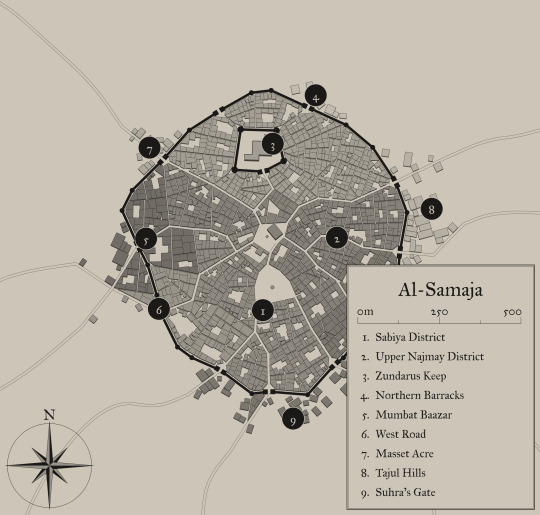
Al-Samaja
A Tevinter city that lies on the boarder of the Silent Plains, and one of the first cities located off the Imperial Highway coming from Nevarra. Al-Samaja works much like Nevarra City, but there is a sense of lawlessness there. Where the Nevarran Black-market had codes of conduct, and the city guards had a council and hierarchy to answer to, Al-Samaja had none. The Desai rules the border city with a dismissive hand - his attention focused more on the politics in the Magisterium - and so all sorts of unsavory characters take advantage where the see it. Bloodstains the corners of every street, and dangerous intent sneers in the smiles of con artists and slavers.
Feel free to use this resource, or to take parts of it your inspiration in your DA RPG campaign! You can find detailed map and district descriptions under the cut.
Suhra’s Gate: This gate leads deep into the Silents Plains, and follows the Imperial Highway back to Nevarra.
Sabiya District: Holds most of the city’s population. The buildings are dense and tall in this area, with brick walls towering over narrow streets. There are many interesting things to find in this district if you dare to venture there.
Upper Najmay District: This district is home to many of the nobility classes, and also home to many practicing mages. The Upper Najmay is full of life, colour, and expensive tastes.
Zundarus Keep: The home and palace of the Desai, and the most highly protected area of the city.
Northern Barracks: A northern fortress that sides on both sides of the city walls, filled with both city guards and mercenaries hired by the Desai and the Viscount.
Mumbat Baazar: A lively market district that stretches dozens upon dozens of city blocks. Music and the delicious smell of cooking food constantly fills the air.
West Road: Is an entrance to the city that creeps down from the treacherous Blackstone Slopes, a mountain pass that leads into the Anderfels
Masset Acre: Is a downtrodden area of the city, and where people cannot find shelter in the city, they risk the dangers beyond the great stone wall, and camp at the gates of Al-Samaja.
Tajul Hills: An expanse of estates and vast land parcels, most belonging to knights, mage scholars, or winter homes for magisters.
#tevinter#world of thedas#thorgans guide to thedas#dragon age rpg#dragon age ttrpg#da rpg#da ttrpg#maps#city map
7 notes
·
View notes
Text
Re-Imagining The Silent Plains
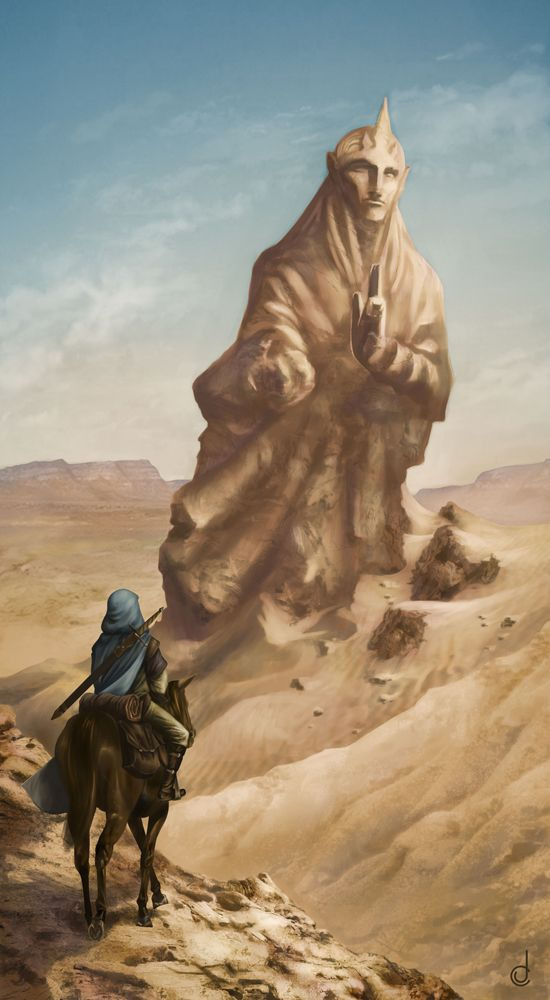
(Artist: Jorge Carrero Roig, Neferu Desert)
The Silent Plains lie between Nevarra and Tevinter - a desolate sandy waste that is hard to travel through, and even harder to live in. Ancient ruins of long lost civilizations are buried in an age’s worth of sand. Take what inspiration you want, for after all, Thorgan’s Guide to Thedas is not set in stone and is meant to be accessed as a tool to build Thedas in the way you want.
Brekka Outpost and it’s Inhabitants
After the Chieftan Movran was banished to the outskirts of Tevinter, he and the rest of his clan have set up an outpost in the Wastes - a contested area of the Plains that neither Tevinter nor Nevarra have control over. Neither nation is entirely interested in the wasteland of the desert, and therefore certain people have began to thrive unchecked in the sandy landscape as they learn and adapt to make their environment fruitful.

(Huacachina Oasis, Peru - Photographer: Ingo Mehling)
Movran and his clan are the only larger-scale village within the desert boundaries, setting up a solid foundation thanks to the resources provided by the Inquisition. Brekka is one of the only safe places across the Plains that a traveler can rest their head without worry, stock up on supplies, and trade goods with a wealthy local market.
Medjay of the Plains

(Artist: John Dunivant, the Danji Alliance)
Many centuries ago, the people of the Plains sought help and protection for the travelers of the Imperial Highway. Thieves, smugglers, and horrible beasts ran rampant through the desert, making travelling even short distances incredibly dangerous - let alone crossing the Plains. Due to the territorial conflict between Tevinter and Nevarra and their unset boarders through the desert, neither country wanted to dedicate the resources to provide soldiers to protect the highway. From this decision, the people of the Plains rallied their own warriors for protection.
Now, the age-old tradition of training Medjay continues, despite interest from both Nevarra and Tevinter to become more involved in the control of the Imperial Highway. The Medjay stay loyal to the people and the desert, and have developed their own code of practice to follow, unbiased to either nation that surrounds them.
The Medjay has been deemed outlaws by the Imperium, but remain travelling the Plains and providing protection to those they come across. Over the generations of influential politics, they have remained unmoved and loyal towards the protection of the people who travel the Plains.
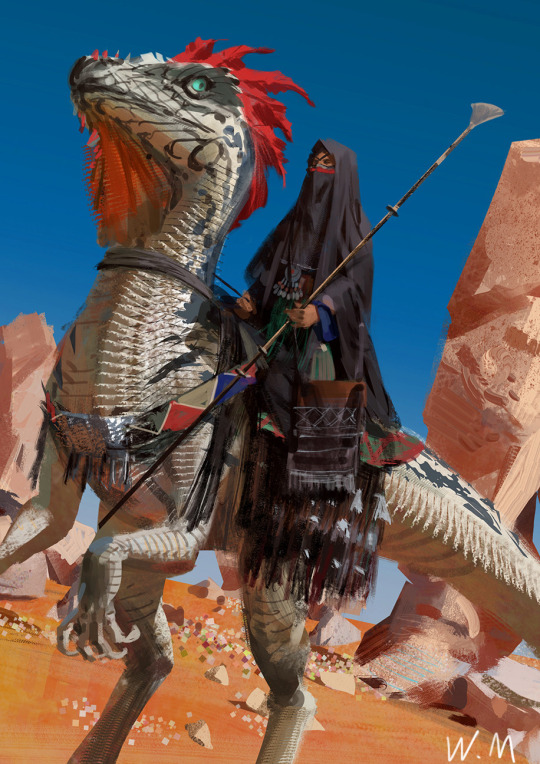
(Artist: Way Way, practice)
Pinterest Inspiration Board
#the silent plains#world of thedas#thorgans guide to thedas#dragon age#dragon age ttrpg#dragon age rpg#dragon age table top#reimagining thedas
5 notes
·
View notes
Text
Knight-Enchanter Specialization for Dragon Age RPG
This specialization appeared as a result of my friend wanting to do what Vivienne does. The official rulebook, of course, has Arcane Warrior, but it’s not quite the same, so I’ve written us our own.
KNIGHT-ENCHANTER
Requirement: Magic and Strength 3 or higher
Novice: Make an activate action and succeed at a TN 15 Magic (Creation) test to make a spirit blade that you wield one-handed or TN 17 Magic (Creation) to make a two-handed blade. It receives appropriate stats, depending on what weapon you are trying to create. The blade exists for a number of rounds equal to your Willpower and deals penetrating damage. Each round you must spend 3d6 Mana points to keep the blade (including the first round you created it).
Journeyman: While you have your spirit blade in your hands and are surrounded by more than 2 enemies, you can try to succeed at a TN 13 Willpower (Self-Discipline) test to restore 1d6 Mana points as a free action.
Master: While you have your spirit blade in your hands, you can make an activate action and attempt a TN 15 Magic (Spirit) test to pull a Fade Cloak around yourself. It is active for a number of turns equal to your Willpower and gives you +1 bonus to Defense and protects against counterattacks.
3 notes
·
View notes
Text
Avvar Shaman Specialization for Dragon Age RPG
It’s probably the most fun part of homebrew stuff I’ve written for Dragon Age ttrpg. It’s loosely based of what lore tells us about avvar mages and their relationship with possession and spirits, and while it may seem overpowered at first, the chaos of it is really fun to have in game, and it provides interesting opportunities for in-game possession.
AVVAR SHAMAN (AUGUR)
Requirement: focus Magic (Spirit), Avvar background
Note: Unlike other specializations, you have to take this one on level 1. You get access to as many spells on your spirit lists as you would if you were generating a character of another background. (I.e. 3 spells on level 1, 4 on level 2, 5 on level 3, etc.)
Raised in a culture that honors the spirits and communicates with them like no other culture, you use magic by connecting with one of the spirits in the Fade and gaining access to their knowledge of magic.
To connect with a spirit, make an activate action, declare what spirit you are trying to find in the Fade, and make a TN 17 Magic (Spirit) test to connect with that particular spirit. If you fail, but your roll is higher than 11, another spirit answers your call, and since your mind was open, you cannot resist a connection to them (the GM rolls d10 to determine which spirit answered from the spirit list). On a roll lower than 11, no spirit answers your call.
To break your connection, you need to make another activate action and succeed at a TN 15 Willpower (Self-Discipline) test. If you fail, on your next turn you must repeat your attempt with another activate action. If you fail again, you must spend your major action to try and sever your connection. On a failure you suffer the consequences of magical mishaps (use Dragon Die of your last Willpower (Self-Discipline) roll to determine what happens). After suffering the mishap, your connection is considered interrupted.
Novice: You can try and connect with a spirit once during a scene. A scene is considered complete when either time or place significantly changes, or when a combat is complete. The GM has a final say for if a scene is over or not.
Journeyman: You can try and connect with different spirits three times per scene.
Master: You can try and converse with spirits you know beyond the bound of Fade (when you are not asleep) and get useful information and advice from them. To do that, you must succeed at a TN 15 Magic (Spirit) test. The spirits can only tell you what they glimpsed from memories of others that they’ve seen. If you are connected to a spirit when you attempt this, you can only try and get the information from them, but TN for the test is 13, and not 15. To do this during combat, you must spend a minor action.
List of spells for spirits is here
11 notes
·
View notes